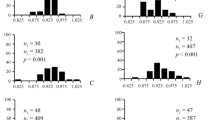Abstract
INVESTIGATIONS on the population dynamics of the diamondback moth, Plutella maculipennis (Curt.), at Ottawa1,2 revealed that its numbers were regulated by factors affecting the adult stage. One of the more important of these was fecundity of the insect, which declined during the season. More recent findings, communicated here, indicate that fecundity is influenced by photoperiod.
Similar content being viewed by others
References
Harcourt, D. G., Canad. Entomol., 93, 820 (1961).
Harcourt, D. G., Canad. Entomol. Mem., 32, 55 (1963).
Hardy, J. E., Bull. Entomol. Res., 29, 343 (1938).
Marsh, O. H., J. Agr. Res., 10, 1 (1917).
Ullyet, G. C., S. Africa Dept. Agr. and Forestry Mem., 2, 77 (1947).
Edwards, W. H., J. Jamaica Agr. Soc., 34, 582 (1930).
Harcourt, D. G., Canad. Entomol., 89, 554 (1957).
Wigglesworth, V. B., The Principles of Insect Physiology, fifth ed. (Methuen and Co., London, 1953).
Harwood, R. F., Ann. Entomol. Soc. Amer., 57, 596 (1964).
Author information
Authors and Affiliations
Rights and permissions
About this article
Cite this article
HARCOURT, D., CASS, L. Photoperiodism and Fecundity in Plutella maculipennis (Curt.). Nature 210, 217–218 (1966). https://doi.org/10.1038/210217a0
Issue Date:
DOI: https://doi.org/10.1038/210217a0
- Springer Nature Limited
This article is cited by
-
10.1007/BF00369138
CrossRef Listing of Deleted DOIs (2011)




